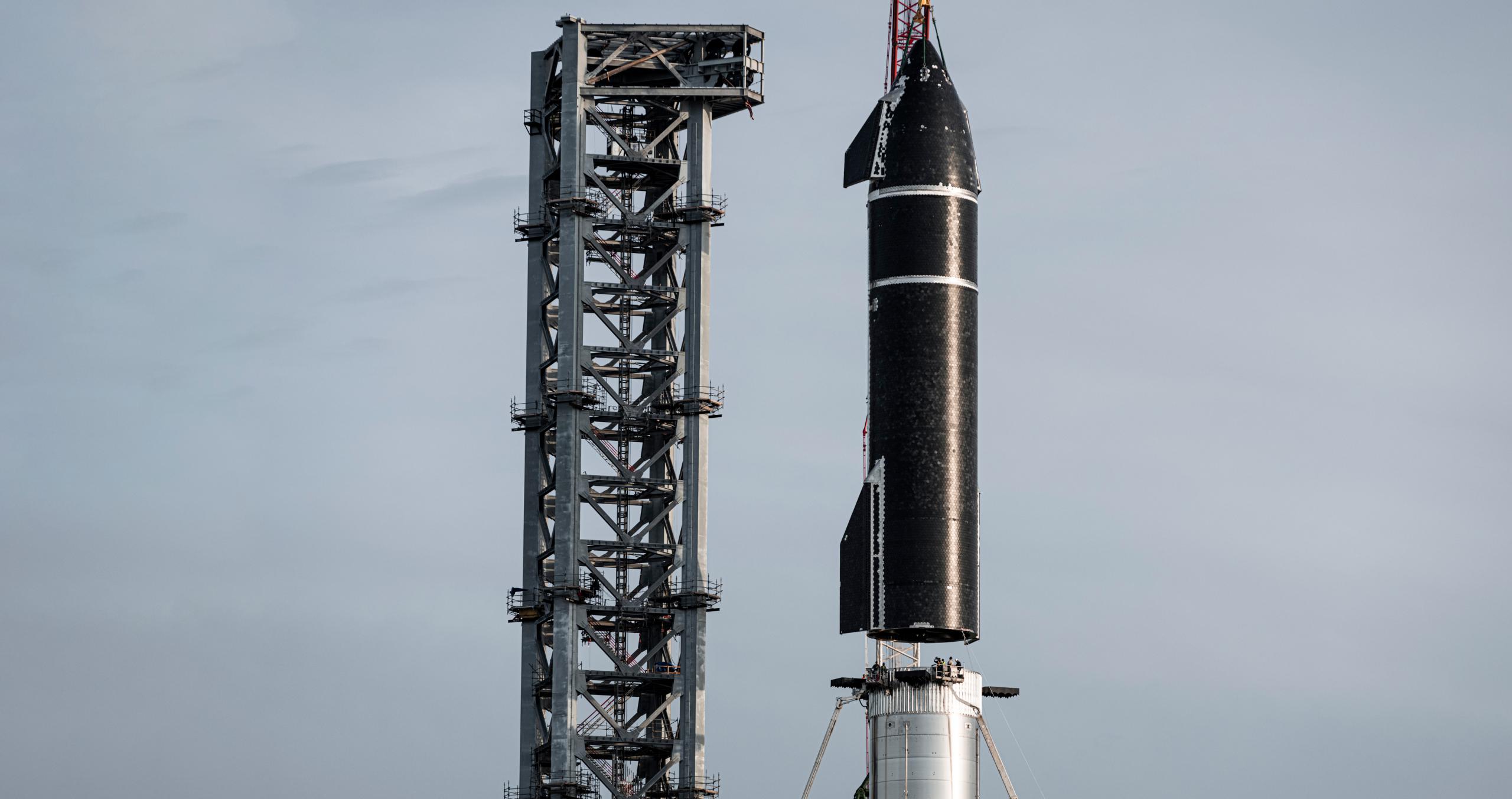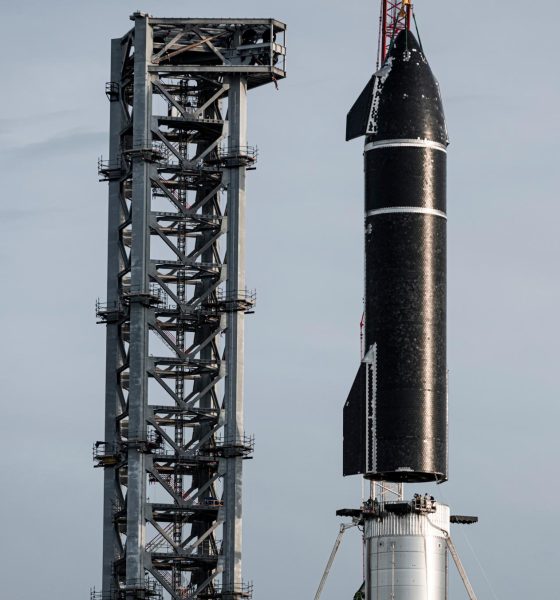

News
SpaceX Starship briefly becomes largest rocket in history – now what’s next?
On August 6th, after a great deal of anticipation, SpaceX stacked a Starship on top of a Super Heavy booster for the first time ever, very briefly assembling the largest rocket in history.
However, barely an hour after the two stages were integrated and (presumably) latched together, SpaceX lifted Starship (S20) off the booster, returned it to its transport stand, and rolled the ship back to the build site later that day. Though an extreme sensitivity to wind conditions has delayed the procedure, Super Heavy Booster 4 (B4) also appears to be on track to be removed from the orbital launch mount and sent either back to the factory or to a suborbital launch mount that’s been modified for booster testing.
For those that followed the process closely in the days and weeks prior, the fact that Starship’s first full assembly was just a fit check (and, really, more like 50:50 between fit check and photo op) came as no surprise. In the lead-up, it became clear through several reports that CEO Elon Musk had challenged SpaceX to stack Ship 20 and Booster 4 by August 5th and flown in several hundred employees normally stationed elsewhere to accomplish the feat.
Ignoring weather delays that prevented stacking on August 5th, SpaceX met Musk’s challenge in all but the literal sense, assembling the world’s largest rocket into one integrated stack for the first time ever. Even more significantly, despite the fact that SpaceX could have easily decided to stack two not-for-flight prototypes to sort of achieve the same feat, both stages – Ship 20 and Booster 4 – involved in the August 6th milestone are nominally destined for flight.
Barring surprises, the same exact pair is scheduled to support Starship’s first orbital test flight as early as this year. Before they can be cleared for flight, however, a great deal of work must still be completed – work that in some cases is unprecedented in the history of the Starship program.
Not long after the stacking milestone, Musk himself sketched out a few of the tasks still in front of the rocket. Namely, Musk says that SpaceX must still complete Starship S20’s partially-finished heat shield, install some form of heat shield(s) to protect Super Heavy Booster 4’s 29 naked Raptor engines; finish installing, plumbing, and activating 4-7 massive custom propellant storage tanks; and assemble, install, and activate a giant mechanical umbilical arm on the launch tower to fuel and power Starship.
All are undoubtedly crucial and Starship is unlikely to launch before any of them are more or less complete. However, the booster and ship themselves are arguably far more of a pressure point. Before they can be deemed ready for flight, both the ship and booster must complete unprecedented test campaigns on the ground.
Ship 20 will need to complete cryogenic proof testing to verify that the first Starship with six Raptor engine mounts is structurally sound. SpaceX has already modified one of its two suborbital Starship launch mounts for that purpose. Once cryo proof and hydraulic ram testing is complete, those six rams will likely be removed and six Raptor engines will be installed in their place, potentially setting up Ship 20 to become the first Starship prototype to static fire six engines – and any number of Raptor Vacuum engines.
Super Heavy Booster 4 will be faced with an even more ambitious static fire test campaign as SpaceX likely gradually installs more and more engines. Depending on how focused SpaceX is on speed over thoroughness, that process could involve gradually adding 2-5 engines after every static fire or could result in SpaceX starting with 4-9 engines and then immediately jumping from 9 to a full 29-Raptor static fire.
Only after completing those crucial qualification tests is SpaceX likely to stack Ship 20 and Booster 4 for a second time and enter the first true full-stack Starship launch flow – hopefully culminating in the first orbital launch attempt later this year, but only as soon as the FAA completes an environmental review and approves the rocket’s launch license. Technically, FAA approval could come next month or it could take the agency a year or more – it’s almost impossible to predict without official information. However, given SpaceX’s track record with Starship prototypes and Booster B3, it’s likely that a flightworthy Starship and Super Heavy will be stacked on the pad and ready to launch just a few months from now.
Stay tuned for updates on that potential standoff in the making and Starship’s progress towards its first orbital test flight.

News
Tesla China delivery centers look packed as 2025 comes to a close
Needless to say, it appears that Tesla China seems intent on ending 2025 on a strong note.

Tesla’s delivery centers in China seem to be absolutely packed as the final days of 2025 wind down, with photos on social media showing delivery locations being filled wall-to-wall with vehicles waiting for their new owners.
Needless to say, it appears that Tesla China seems intent on ending 2025 on a strong note.
Full delivery center hints at year-end demand surge
A recent image from a Chinese delivery center posted by industry watcher @Tslachan on X revealed rows upon rows of freshly prepared Model Y and Model 3 units, some of which were adorned with red bows and teddy bears. Some customers also seem to be looking over their vehicles with Tesla delivery staff.
The images hint at a strong year-end push to clear inventory and deliver as many vehicles as possible. Interestingly enough, several Model Y L vehicles could be seen in the photos, hinting at the demand for the extended wheelbase-six seat variant of the best-selling all-electric crossover.
Strong demand in China
Consumer demand for the Model Y and Model 3 in China seems to be quite notable. This could be inferred from the estimated delivery dates for the Model 3 and Model Y, which have been extended to February 2026 for several variants. Apart from this, the Model Y and Model 3 also continue to rank well in China’s premium EV segment.
From January to November alone, the Model Y took China’s number one spot in the RMB 200,000-RMB 300,000 segment for electric vehicles, selling 359,463 units. The Model 3 sedan took third place, selling 172,392. This is quite impressive considering that both the Model Y and Model 3 are still priced at a premium compared to some of their rivals, such as the Xiaomi SU7 and YU7.
With delivery centers in December being quite busy, it does seem like Tesla China will end the year on a strong note once more.
News
Tesla Giga Berlin draws “red line” over IG Metall union’s 35-hour week demands
Factory manager André Thierig has drawn a “red line” against reducing Giga Berlin’s workweek to 35 hours, while highlighting that Tesla has actually increased its workers’ salaries more substantially than other carmakers in the country.

Tesla Giga Berlin has found itself in a new labor dispute in Germany, where union IG Metall is pushing for adoption of a collective agreement to boost wages and implement changes, such as a 35-hour workweek.
In a comment, Giga Berlin manager André Thierig drew a “red line” against reducing Giga Berlin’s workweek to 35 hours, while highlighting that Tesla has actually increased its workers’ salaries more substantially than other carmakers in the country.
Tesla factory manager’s “red line”
Tesla Germany is expected to hold a works council election in 2026, which André Thierig considers very important. As per the Giga Berlin plant manager, Giga Berlin’s plant expansion plans might be put on hold if the election favors the union. He also spoke against some of the changes that IG Metall is seeking to implement in the factory, like a 35-hour week, as noted in an rbb24 report.
“The discussion about a 35-hour week is a red line for me. We will not cross it,” Theirig said.
“(The election) will determine whether we can continue our successful path in the future in an independent, flexible, and unbureaucratic manner. Personally, I cannot imagine that the decision-makers in the USA will continue to push ahead with the factory expansion if the election results favor IG Metall.”
Giga Berlin’s wage increase
IG Metall district manager Jan Otto told the German news agency DPA that without a collective agreement, Tesla’s wages remain significantly below levels at other German car factories. He noted the company excuses this by referencing its lowest pay grade, but added: “The two lowest pay grades are not even used in car factories.”
In response, Tesla noted that it has raised the wages of Gigafactory Berlin’s workers more than their German competitors. Thierig noted that with a collective agreement, Giga Berlin’s workers would have seen a 2% wage increase this year. But thanks to Tesla not being unionized, Gigafactory Berlin workers were able to receive a 4% increase, as noted in a CarUp report.
“There was a wage increase of 2% this year in the current collective agreement. Because we are in a different economic situation than the industry as a whole, we were able to double the wages – by 4%. Since production started, this corresponds to a wage increase of more than 25% in less than four years,” Thierig stated.
News
Tesla is seeing a lot of momentum from young Koreans in their 20s-30s: report
From January to November, young buyers purchased over 21,000 Teslas, putting it far ahead of fellow imported rivals like BMW and Mercedes-Benz.

Tesla has captured the hearts of South Korea’s 20s-30s demographic, emerging as the group’s top-selling imported car brand in 2025. From January to November, young buyers purchased over 21,000 Teslas, putting it far ahead of fellow imported rivals like BMW and Mercedes-Benz.
Industry experts cited by The Economist attributed this “Tesla frenzy” to fandom culture, where buyers prioritize the brand over traditional car attributes, similar to snapping up the latest iPhone.
Model Y dominates among young buyers
Data from the Korea Imported Automobile Association showed that Tesla sold 21,757 vehicles to the 20s-30s demographic through November, compared to BMW’s 13,666 and Mercedes-Benz’s 6,983. The Model Y led the list overwhelmingly, with variants like the standard and Long Range models topping purchases for both young men and women.
Young men bought around 16,000 Teslas, mostly Model Y (over 15,000 units), followed by Model 3. Young women followed a similar pattern, favoring Model Y (3,888 units) and Model 3 (1,083 units). The Cybertruck saw minimal sales in this group.
The Model Y’s appeal lies in its family-friendly SUV design, 400-500 km range, quick acceleration, and spacious cargo, which is ideal for commuting and leisure. The Model 3, on the other hand, serves as an accessible entry point with lower pricing, which is valuable considering the country’s EV subsidies.
The Tesla boom
Experts described Tesla’s popularity as “fandom culture,” where young buyers embrace the brand despite criticisms from skeptics. Professor Lee Ho-geun called Tesla a “typical early adopter brand,” comparing purchases to iPhones.
Professor Kim Pil-soo noted that young people view Tesla more as a gadget than a car, and they are likely drawn by marketing, subsidies, and perceived value. They also tend to overlook news of numerous recalls, which are mostly over-the-air software updates, and controversies tied to the company.
Tesla’s position as Korea’s top import for 2025 seems secured. As noted by the publication, Tesla’s December sales figures have not been reported yet, but market analysts have suggested that Tesla has all but secured the top spot among the country’s imported cars this year.








